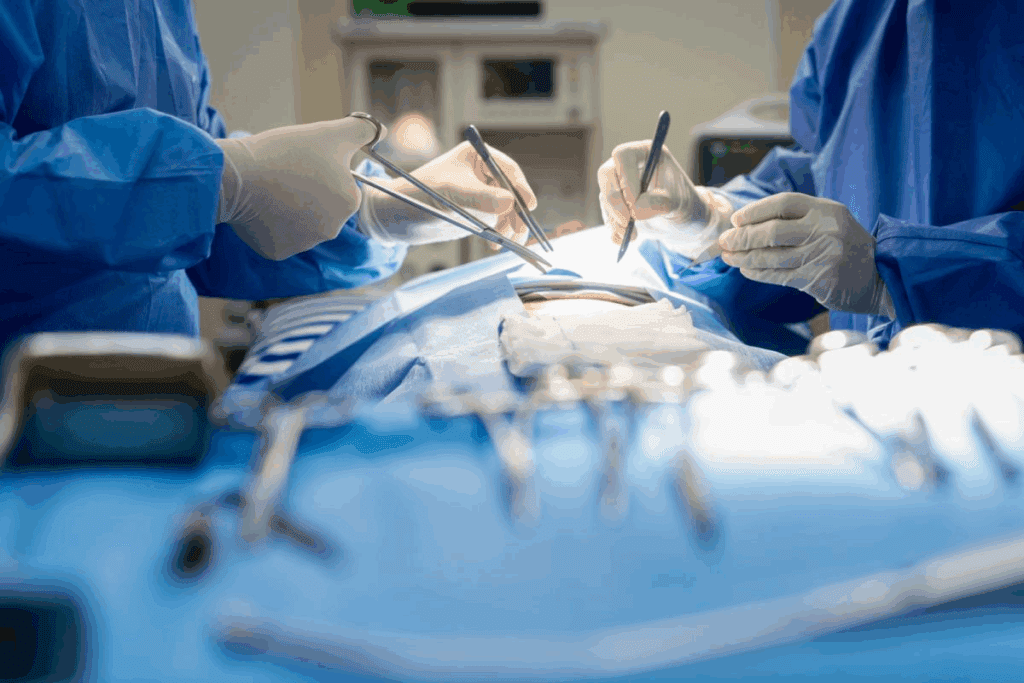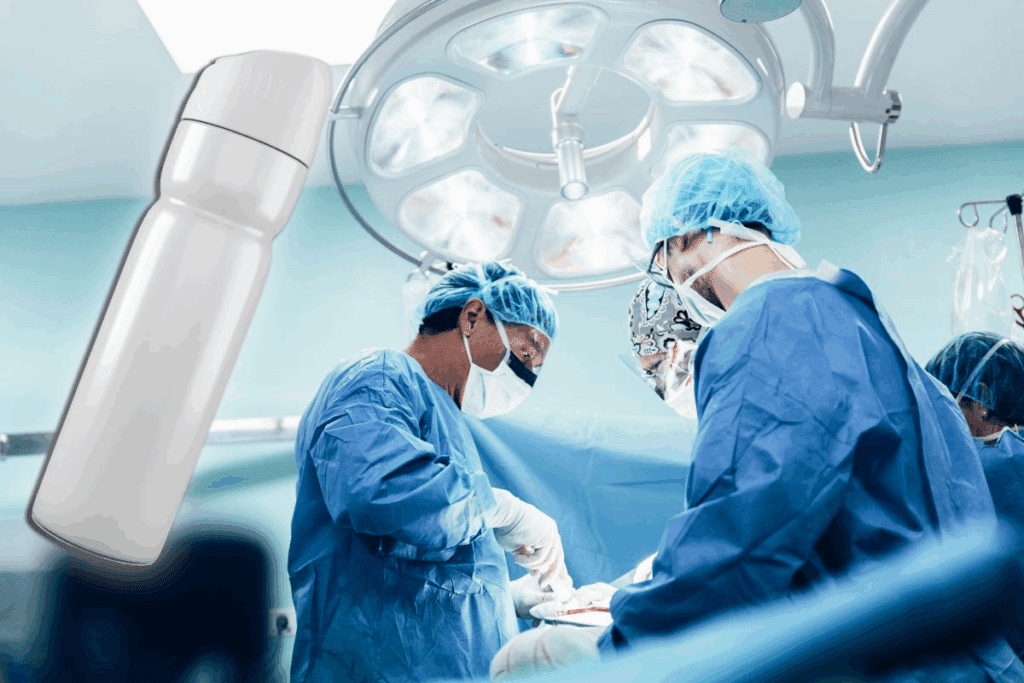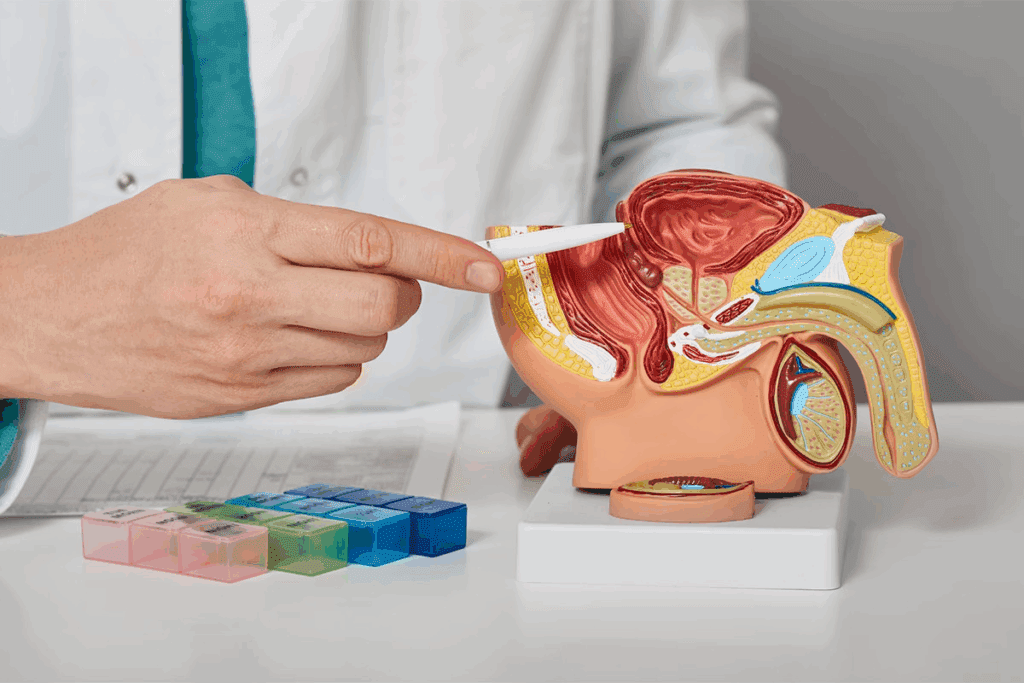Last Updated on October 30, 2025 by mcelik

At Liv Hospital, we know that getting a prostate biopsy can be scary. A prostate biopsy is key for finding prostate cancer. We aim to give you the best care and advice every step of the way.
Learn how is a prostate biopsy performed and what the recovery process is like.
The biopsy takes core samples from the prostate using a special needle. It’s guided by ultrasound or MRI. The whole thing is done with local anesthesia to keep you comfortable. It usually takes under 45 minutes.
Knowing what to expect during recovery can make things easier. It helps you feel more at ease and makes the process smoother.

A prostate biopsy is a key test to find cancer or other issues in the prostate. It takes a tissue sample from the prostate gland. This sample is then checked under a microscope for any unusual cell growth.
A prostate biopsy is a procedure where a urologist takes tissue samples from the prostate gland. The prostate gland is a small gland below the bladder in men. It surrounds the urethra. The main goal of this biopsy is to check for prostate cancer or other prostate problems.
Doctors suggest prostate biopsies for several reasons. They often do this based on initial screenings. If a patient’s PSA level is high, or if a digital rectal exam (DRE) shows abnormalities, a biopsy might be needed. These tests can show signs of prostate cancer or other issues, leading to a biopsy for a closer look.
A prostate biopsy is needed when initial tests show possible prostate problems. Doctors decide on a biopsy based on PSA blood test results and DRE findings. If these tests show high PSA levels or a suspicious lump, a biopsy is usually the next step to confirm the diagnosis.
| Indicator | Normal Result | Abnormal Result | Action |
| PSA Level | 0-4 ng/mL | Above 4 ng/mL | Biopsy Considered |
| Digital Rectal Exam (DRE) | Normal Prostate Texture | Suspicious Lump or Hardness | Biopsy Recommended |
| Biopsy Result | No Cancer Cells | Cancer Cells Detected | Treatment Options Discussed |
Knowing about prostate biopsies helps patients get ready for the procedure and its possible results. It’s a vital step in diagnosing prostate cancer and other prostate issues. This allows for timely and proper treatment.

There are several ways to do a prostate biopsy, each with its own benefits and uses. It’s important for patients to understand these differences to make the best choice for their care.
TRUS is a common method for prostate biopsy. It uses ultrasound to guide the needle through the rectum into the prostate. TRUS is widely available and familiar to most urologists, making it a top choice for many.
The transperineal approach makes a small incision in the perineum to reach the prostate. It’s becoming more popular because it might lower the risk of infection compared to TRUS. It’s a good option for patients at higher risk of infection.
MRI-guided biopsy uses MRI to target specific areas of the prostate. It’s great for patients with suspicious lesions seen on MRI. MRI-guided biopsy can improve the detection of clinically significant prostate cancer, helping to catch cancer that other methods might miss.
Each biopsy method has its own safety and effectiveness. The right choice depends on the patient’s health, prostate size, and specific concerns.
| Biopsy Method | Safety Profile | Effectiveness |
| TRUS | Generally safe, but carries a risk of infection | Effective for sampling prostate tissue |
| Transperineal | Lower risk of infection compared to TRUS | Highly effective, specially for anterior tumors |
| MRI-Guided | Safe, with precise targeting of suspicious areas | Highly effective for detecting significant cancer |
As shown in the table, each method has its own benefits. The choice of biopsy technique should be based on the individual patient’s needs and clinical situation.
Getting ready for a prostate biopsy is key. It involves several steps to make the process easier. We’ll help you prepare to make it as comfortable as possible.
Your doctor will check you before the biopsy. This includes blood tests and looking at your medical history. They want to make sure you’re safe for the procedure.
You might need to change your medications. This could mean stopping blood thinners to avoid bleeding. Always talk to your doctor before changing your meds.
There might be foods and activities you should avoid. You might need to stop heavy lifting or eating certain foods. Your doctor will tell you what to do.
Getting mentally ready is important too. Knowing what to expect can help calm your nerves. Bring your documents, a support person, and follow your doctor’s advice.
| Preparation Step | Description |
| Medical Evaluations | Blood tests, medical history review, and other assessments |
| Medication Adjustments | Stopping blood thinners and other necessary medication changes |
| Dietary Restrictions | Avoiding certain foods and drinks before and after the biopsy |
| Activity Restrictions | Avoiding heavy lifting and strenuous activities |
| Mental Preparation | Understanding the procedure and what to expect |
By following these steps, you can make your prostate biopsy go smoothly.
We will guide you through the step-by-step process of a prostate biopsy. This ensures you’re well-prepared for what’s to come. A prostate biopsy is a diagnostic procedure where tissue samples are taken from the prostate gland for examination.
The first step in the prostate biopsy procedure involves positioning the patient correctly. Patients are usually asked to lie on their side or back. Their legs are elevated and placed in stirrups, similar to a pelvic exam. This positioning allows the doctor to access the prostate gland easily.
Preparation is key to a successful biopsy. Patients may need to follow specific dietary restrictions or medication adjustments before the procedure. It’s also essential to discuss any allergies or medical conditions with your healthcare provider.
To minimize discomfort during the procedure, local anesthesia is administered to numb the area around the prostate. The type and amount of anesthesia can vary depending on the biopsy method and individual patient needs.
The administration of anesthesia is typically done through an injection, which may cause a brief stinging sensation. Once the anesthesia takes effect, the patient should not feel pain during the sampling process.
During the biopsy, a biopsy needle is used to retrieve tissue samples from the prostate gland. The needle is guided by imaging technology, such as ultrasound or MRI, to ensure accurate sampling.
The number of samples taken can vary, but typically, multiple samples are collected from different areas of the prostate. This helps in getting a complete view of the prostate’s condition.
The duration of a prostate biopsy procedure can vary, but it usually takes between 15 to 60 minutes to complete. The actual time depends on the complexity of the procedure, the method used, and the individual patient’s condition.
| Biopsy Method | Typical Duration | Notable Characteristics |
| Transrectal Ultrasound-Guided Biopsy (TRUS) | 15-30 minutes | Commonly used, involves ultrasound guidance |
| Transperineal Biopsy | 30-60 minutes | Involves a template grid for precise sampling |
| MRI-Guided Biopsy | 30-60 minutes | Uses MRI for detailed imaging and targeting |
Understanding the step-by-step process of a prostate biopsy can help alleviate concerns and prepare you for the procedure. If you have any further questions or need clarification on any aspect, it’s always best to consult with your healthcare provider.
It’s important for patients to know about the pain level of a prostate biopsy. We’ll talk about the anesthesia used, what sensations you might feel, and how to handle anxiety about pain.
Several types of anesthesia are used to reduce discomfort during a prostate biopsy. Local anesthesia numbs the area around the prostate gland. It’s often given through a periprostatic block, which targets the nerves around the prostate.
Some procedures might also use conscious sedation. This helps patients relax and feel more at ease during the biopsy.
Even with local anesthesia, some patients might feel certain sensations. You might feel a stinging or pinching when the anesthetic is injected. During the biopsy, you might feel a mild pressure or discomfort.
Pain experiences during a prostate biopsy vary. Many say the pain is mild and manageable. Thanks to local anesthesia, the procedure is more tolerable. But, how much pain you feel can depend on your personal pain threshold.
It’s key to manage anxiety about pain before a prostate biopsy. Talk to your healthcare provider about your worries. They can explain the pain management strategies they’ll use. Knowing these steps can help reduce your anxiety and make the procedure less scary.
After a prostate biopsy, taking care of yourself right away is key. We know you might have lots of questions and worries. Our goal is to help you through this time, making sure you’re safe and comfortable.
Right after the biopsy, you’ll be watched closely for any problems. This usually happens in the clinic or hospital. They’ll check your vital signs and look for any bad reactions.
After the watchful period, you’ll get some recovery tips. You’ll learn about resting, avoiding hard work, and handling any pain. It’s very important to listen to these tips to avoid more problems.
Your doctor will decide when you can leave after the biopsy. Most people can go home soon after, if there are no issues. But, it’s a good idea to have someone with you, as you might feel tired or not feel well.
The first day after your biopsy is very important for getting better. Here are some tips to follow:
| Activity | Guideline |
| Resting | Avoid strenuous activities and rest as much as possible. |
| Diet | Stick to a light diet and stay hydrated. |
| Pain Management | Follow your doctor’s advice on managing pain or discomfort. |
By following these tips, you can make sure your recovery from the biopsy goes smoothly and safely.
Knowing what happens after a prostate biopsy can ease worries and make healing easier. We’ll talk about common symptoms, how to handle pain, what activities to avoid, and what to eat.
After a prostate biopsy, you might feel a few things. These include:
These symptoms usually go away in a few days. But if they don’t or get worse, call your doctor.
It’s important to manage pain and discomfort after a biopsy. Here’s how:
Always follow your doctor’s advice on pain relief.
Some activities should be avoided for a smooth recovery. We recommend:
| Activity | Recommended Avoidance Period |
| Strenuous exercise or heavy lifting | At least 24-48 hours |
| Sexual intercourse | Typically 1-3 days, as advised by your doctor |
| Long car rides or travel | As recommended by your healthcare provider |
Eating right is key during recovery. We suggest:
Knowing what to expect after a biopsy helps patients care for themselves better. If you have any questions or concerns, always talk to your doctor.
The time it takes to recover from a prostate biopsy depends on a few things. These include the type of biopsy done. We’ll explain the usual recovery times for different biopsy methods and what can affect your healing.
For those who get a transrectal ultrasound-guided biopsy (TRUS), recovery is usually fast. Most men can get back to their normal life in 24 to 48 hours.
Transperineal biopsy, which takes tissue samples through the perineum, might take a bit longer to recover from. Patients usually need 2 to 3 days to get back to their usual routine.
Several things can affect how fast you recover from a prostate biopsy. These include your health, age, and any medical conditions you have. Also, the skill of your healthcare provider and the biopsy technique used can influence your recovery.
It’s very important to follow your doctor’s instructions closely. This helps avoid complications and ensures a smooth recovery.
Recovery times can differ, but most men can get back to their normal activities in a few days to a week after the biopsy. It’s best to avoid hard work, heavy lifting, and bending over for a few days after the procedure.
| Biopsy Type | Typical Recovery Time | Notes |
| Transrectal Biopsy (TRUS) | 24-48 hours | Quick recovery, most men resume normal activities within 2 days |
| Transperineal Biopsy | 2-3 days | May require a slightly longer recovery period |
Summary: Recovery from a prostate biopsy varies based on the biopsy method and individual health factors. By understanding the typical recovery timelines and following your healthcare provider’s guidance, you can ensure a smooth and effective recovery process.
Prostate biopsies are usually safe but can have some complications. It’s important to know about these issues to get the right care and seek help when needed.
Common issues include infection, bleeding, and trouble urinating. Infection is a big worry because bacteria can get into the urinary tract. Bleeding might show up as blood in urine, semen, or stool. It’s usually short-lived but can scare patients.
If you have severe symptoms or signs of infection, get medical help right away. Look out for:
As a medical expert says, “Quick action and treatment can greatly improve outcomes.”
“The key to managing complications is early detection and appropriate intervention.”
To lower infection risk, you might get antibiotics before and after the biopsy. Keeping clean and following care instructions are also key. Talk to your doctor about any concerns or allergies to make your prevention plan fit you.
Some rare side effects include ongoing bleeding or urinary problems. Keeping an eye on these and talking to your doctor is vital. Regular check-ups can help catch and manage long-term issues early.
Knowing about possible complications and taking steps to prevent them can help you recover better.
Patients often wonder how long it takes to get their prostate biopsy results. The wait can be stressful. But knowing the typical time frame and what to expect can ease the anxiety.
Usually, you’ll get your biopsy results in 5 to 10 business days. But, this can change based on the lab’s workload and the sample’s complexity.
Factors Influencing Result Timelines:
When your results are ready, your doctor will talk them over with you. The results might show benign conditions, inflammation, or cancer. It’s key to understand what your results mean for your care.
It’s essential to ask your healthcare provider about any concerns or questions you have regarding your results.
| Result Type | Description | Next Steps |
| Benign | No cancer cells found | Continue regular check-ups |
| Cancerous | Cancer cells detected | Discuss treatment options with your doctor |
| Inflammatory | Inflammation present, no cancer | Potential treatment for inflammation, follow-up |
After getting your biopsy results, your doctor will set up a follow-up. They’ll go over the findings and talk about any needed treatment or tests.
Waiting for biopsy results can be tough emotionally. It’s important to lean on family, friends, or support groups. Your healthcare team is also there to help with any worries or questions.
Deciding on prostate health can be tough, but knowing what to do is key. We’ve looked at prostate biopsy, its purpose, and the different ways it’s done. This helps you make better choices for your health.
We’ve talked about getting ready for the biopsy, what happens during and after, and how to recover. Knowing these things is important for navigating prostate health decisions well. This way, you can prepare for what’s coming next.
Prostate health is very important for men, and making smart choices about tests like biopsies is vital. We suggest talking to doctors about your needs and worries. This way, you can take care of your prostate health in a way that fits you best.
A prostate biopsy is a procedure where doctors take a tissue sample from the prostate gland. They examine it under a microscope to check for cancer or other issues.
A prostate biopsy is needed when PSA test results or a digital rectal exam show something abnormal. This suggests a possible problem with the prostate gland.
While a prostate biopsy might be uncomfortable, it’s usually managed with anesthesia or pain medication. Most people don’t find it very painful.
The biopsy itself usually takes 15 to 60 minutes. This depends on the method used and the case’s complexity.
Recovery time varies. Transrectal biopsies usually need a few days of rest. Transperineal biopsies might take longer.
After a prostate biopsy, you might feel discomfort, pain, or a heavy feeling in your pelvic area. You could also experience bleeding or infection.
Results from a prostate biopsy usually come within a few days to a week. But this can vary based on the lab and the analysis’s complexity.
Complications can include infection, bleeding, and temporary urinary issues. It’s important to follow your doctor’s instructions to reduce these risks.
To manage discomfort and pain, take pain medication as directed by your doctor. Also, follow the post-procedure care instructions carefully.
If you have severe pain, heavy bleeding, trouble urinating, or signs of infection like fever or chills, seek medical help right away.
Yes, you should avoid strenuous activities, heavy lifting, and certain exercises for a while after the biopsy. This helps with recovery.
The main types are transrectal ultrasound-guided biopsy (TRUS), transperineal biopsy, and MRI-guided biopsy. Each has its own benefits and considerations.
To prepare, undergo medical evaluations, adjust medications as advised, follow dietary and activity restrictions, and mentally prepare for the procedure.
ScienceDirect. (2012). Minimally invasive treatment of varicose veins. Galanopoulos, G. (2012). Retrieved from https://www.sciencedirect.com/science/article/pii/S1743919112000313
Subscribe to our e-newsletter to stay informed about the latest innovations in the world of health and exclusive offers!
WhatsApp us